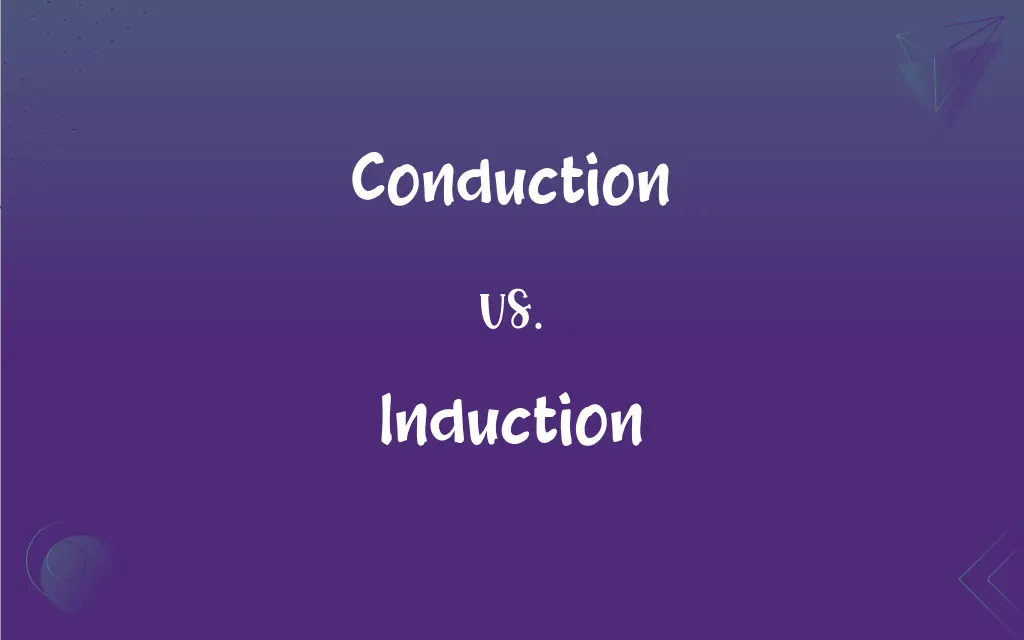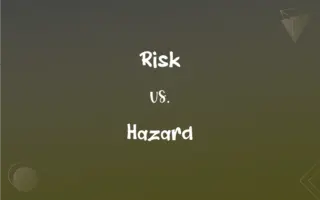Conduction vs. Induction: What's the Difference?
Edited by Janet White || By Harlon Moss || Updated on October 22, 2023
Conduction is the transfer of heat or electricity through a substance without the movement of the substance, while induction is the initiation or cause of a process, often without direct contact.

Key Differences
Conduction pertains to the process where heat or electricity moves through a substance, usually a solid. On the other hand, induction relates to the phenomenon where a change is initiated in an object due to its proximity to another object with energy, but without direct contact.
In the realm of heat transfer, conduction happens when heat moves through a solid material, like a metal spoon in a hot soup. Induction, in the context of electricity, refers to the generation of a current in a conductor by changing the magnetic field nearby without the two touching.
With conduction, there's a direct transfer. For instance, when you touch a hot pan, the heat is conducted from the pan to your hand. Induction doesn't require this direct touch. A good example of electrical induction is a wireless charger that charges a device without physically connecting to it.
When understanding conduction, it's essential to recognize that some materials, like metals, are good conductors. They allow heat or electricity to pass through them efficiently. Induction, especially in electromagnetism, leans on the principle that a change in the magnetic environment of a coil of wire induces a voltage in the wire.
Conduction is fundamental in many daily life examples, like cooking on a stove or using electrical wires. Induction has its significance in various applications too, from induction cooktops to the working principles of transformers in electrical systems.
ADVERTISEMENT
Comparison Chart
Nature
Direct transfer of heat or electricity
Initiation of a process without direct contact
Requires Contact?
Yes
No
Examples
Heat in a metal rod, electrical wires
Wireless chargers, induction cooktops
Materials Involved
Usually solids like metals
Conductors in changing magnetic fields
Usage in Daily Life
Cooking on a stove, electrical devices
Induction cooktops, transformers
ADVERTISEMENT
Conduction and Induction Definitions
Conduction
It refers to the movement of electricity through a conductor.
Electrical conduction ensures our devices work when plugged in.
Induction
It's used in various appliances like induction cooktops.
I cooked dinner faster using the induction stove.
Conduction
Conduction is the transfer of heat through a material.
The metal rod exhibited conduction when one end was heated.
Induction
Induction initiates a process without direct contact.
The wireless charger uses induction to charge my phone.
Conduction
Conduction happens without the movement of the material itself.
Even though the water remained still, conduction of heat occurred.
Induction
Induction often works with electromagnetic principles.
The experiment demonstrated electromagnetic induction effectively.
Conduction
Conduction requires direct contact for transfer.
When I touched the hot cup, conduction caused my hand to feel warm.
Induction
It's a method of producing electricity in a conductor.
Transformers operate based on the principles of induction.
Conduction
Some materials are better conductors than others.
Silver is known for its high conduction properties.
Induction
Induction results from a changing magnetic field.
The coil experienced induction when exposed to a fluctuating magnetic field.
Conduction
The transmission or conveying of something through a medium or passage, especially the transmission of electric charge or heat through a conducting medium without perceptible motion of the medium itself.
Induction
The act or an instance of inducting.
FAQs
What's an everyday example of induction?
A common example of induction is a wireless phone charger.
What is conduction?
Conduction is the direct transfer of heat or electricity through a substance without the substance's movement.
How does induction differ from conduction?
Induction initiates a process, often electrical, in an object without direct contact, while conduction requires contact.
Can conduction occur in liquids?
Yes, conduction can occur in liquids, but it's typically less effective than in solids.
Is induction limited to electrical phenomena?
While commonly associated with electricity, induction can refer to any initiation of a process without direct interaction.
Why is conduction important in electronics?
Conduction ensures electrical devices function correctly by allowing electricity to move through circuits.
Can induction occur in non-metallic objects?
Yes, induction primarily depends on a changing magnetic field, so non-metals that respond to such fields can experience induction.
How do induction cooktops work?
Induction cooktops use electromagnetic fields to heat cookware directly without heating the surface of the stove.
Can conduction and induction principles be observed together in a system?
Yes, many systems, like some motors or generators, utilize both conduction and induction principles.
Why are metals often used in conduction processes?
Metals are good conductors, allowing efficient heat or electrical transfer.
How does conduction work in cooking?
When a pot is placed on a hot stove, heat is conducted from the stove to the pot, cooking the food inside.
Why don't all materials conduct heat or electricity well?
Different materials have varying atomic structures, affecting their conduction efficiency.
Can induction charge large devices?
With the right setup, induction can charge larger devices, but efficiency may vary.
Is induction safer than conduction for cooking?
Induction cooktops are often considered safer because only the cookware heats up, not the stove's surface.
Is conduction responsible for feeling heat when touching a hot object?
Yes, touching a hot object transfers heat through conduction to your skin.
What role does induction play in transformers?
Transformers use electromagnetic induction to transfer electrical energy between two or more coils.
Can conduction occur in gases?
Yes, but conduction in gases is usually less effective than in solids or liquids.
Does induction always involve electricity?
While often associated with electricity, induction can refer to initiating any process without direct contact.
What factors affect conduction efficiency?
Material properties, temperature differences, and surface area all influence conduction efficiency.
Are some materials resistant to conduction?
Yes, materials like wood or rubber resist electrical and heat conduction.
About Author
Written by
Harlon MossHarlon is a seasoned quality moderator and accomplished content writer for Difference Wiki. An alumnus of the prestigious University of California, he earned his degree in Computer Science. Leveraging his academic background, Harlon brings a meticulous and informed perspective to his work, ensuring content accuracy and excellence.
Edited by
Janet WhiteJanet White has been an esteemed writer and blogger for Difference Wiki. Holding a Master's degree in Science and Medical Journalism from the prestigious Boston University, she has consistently demonstrated her expertise and passion for her field. When she's not immersed in her work, Janet relishes her time exercising, delving into a good book, and cherishing moments with friends and family.































































